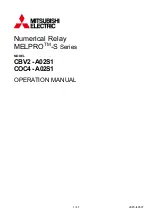
3-22
Differential, Restricted Earth Fault,
Date Code 20020129
Overcurrent, Voltage, and Frequency Elements
SEL-387E Instruction Manual
Restraint Slope Percentage
Example:
The current transformer error, e, is equal to ±10 percent. In per unit:
e = 0.1
The voltage ratio variation of the power transformer load tap-changer, LTC, is from 90 percent to
110 percent. In per unit:
a = 0.1
In a through-current situation, the worst-case theoretical differential current occurs when all of
the input currents are measured with maximum positive CT error, and all of the output currents
are measured with maximum negative CT error as well as being offset by maximum LTC
variation. Therefore, the maximum differential current expected for through-current conditions
is:
(
)
(
)
(
)
Ê
Ê
+
-
-
+
=
"
OUT
"
"
IN
"
IWn
•
a
1
e
1
IWn
•
e
1
max
Id
where the summation terms are the total input and output power transformer secondary currents,
after tap compensation. Because these summations must be equal for external faults and load
current, we can express the maximum differential current as a percentage of winding current:
(
) (
)
(
)
%
18
.
28
%
100
•
a
1
a
•
e
a
e
•
2
a
1
e
1
e
1
=
+
+
+
=
+
-
-
+
In addition to the error calculated above, we have to consider additional errors from transformer
excitation current (
3 percent) and relay measurement error (
5 percent). The maximum total
error comes to 36 percent. Therefore, if we use only one slope, a conservative slope setting,
SLP1, is about 40 percent. This represents a fixed percentage differential application and is a
good average setting to cover the entire current range.
A two-slope, or variable-percentage differential application, improves sensitivity in the region
where CT error is small and increases security in the high-current region where CT error is great.
We must define both slopes, as well as the slope 1 limit or crossover point, IRS1. If we assume
CT error to be only 1 percent, we can set SLP1 at about 25 percent. A good choice for IRS1 is
about 3.0 per unit of tap, while the SLP2 setting should probably be in the 50 percent to 60
percent range to avoid problems with CT saturation at high currents. A 60 percent SLP2 setting
covers CT error to as great as 20 percent.
Unrestrained Element Current Pickup
The instantaneous unrestrained current element is intended to react quickly to very heavy current
levels that clearly indicate an internal fault. Set the pickup level (U87P) to about 10 times TAP.
The unrestrained differential element only responds to the fundamental frequency component of
the differential operating current. It is not affected by the SLP1, SLP2, IRS1, PCT2, PCT5, or
IHBL settings. Thus, it must be set high enough so as not to react to large inrush currents.
Note:
U87P must be set lower than 31 • I
nom
/TAP
max
, where TAP
max
is the largest of the TAP
settings.
Содержание SEL-387E
Страница 8: ......
Страница 10: ......
Страница 12: ......
Страница 50: ......
Страница 124: ......
Страница 176: ......
Страница 196: ......
Страница 198: ......
Страница 242: ......
Страница 270: ......
Страница 308: ......
Страница 422: ......
Страница 428: ......
Страница 432: ......
Страница 448: ......
Страница 450: ......
Страница 462: ......
















































